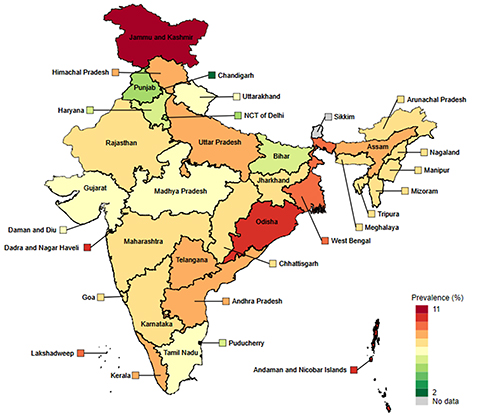New estimate of dementia prevalence indicates magnitude of India’s challenge
March/April 2023 | Volume 22 Number 2
Susan Scutti
By 2050, over 75% of cases of Alzheimer’s disease and related dementias (ADRD) are expected to occur in low-and middle-income countries. Yet, most of the current knowledge of ADRD is based on findings from high-income countries. This fact prompted economics professor Jinkook Lee and her colleagues to design a study, funded in part by the National Institute on Aging, to estimate dementia prevalence in India, home to 18% (1.37 billion people) of the world’s population.
“In India, prior estimates of dementia prevalence were based on samples from selected communities and so inadequately represented the population, which shows significant diversity across geographic regions,” noted the director of the Program on Global Aging, Health, and Policy at the University of Southern California's Center for Economic and Social Research.
Creating a model to estimate prevalence
To begin, Lee and her colleagues recruited more than 4,000 seniors (ages 60 and older) from the Longitudinal Aging Study in India (LASI), the largest national health and retirement study in the world. Participants were interviewed and underwent a series of neuropsychological tests. Next, the researchers obtained a clinical consensus rating of dementia status—a panel of experts reviewed each person’s information, discussed the findings, and rendered a collective diagnosis—for a subsample of 2,528 participants. Then Lee and her colleagues constructed a logistic regression model, a type of statistical model frequently used to predict outcomes, to deduce the dementia status for all other LASI seniors, a total of 28,949 people.
Lee’s team gauged that dementia prevalence in India is 7.4% among adults over the age of 60—meaning about 8.8 million Indians are currently living with dementia. “This is greater than the Dementia in India 2020 Report estimate of 5.3 million,” Lee told Fogarty in an email. It is also closer to dementia rates in both the U.S. (8.6%) and the U.K. (7.1%). Additionally, Lee’s study found that impairment of everyday activities associated with decreased cognitive function is more common among females than males and in rural than urban areas. The team also saw significant cross-state variation.
 Image courtesy of Dr. Jinkook LeeMap showing the prevalence of dementia by state in India with dark red signifying the highest prevalence and dark green the lowest. While 7.4% is the estimated dementia prevalence rate for adults aged 60 and older across the country, the map shows it is unevenly distributed across Indian states. (A
table representing this same data can be found on the Alzheimer's & Dementia website.)
Image courtesy of Dr. Jinkook LeeMap showing the prevalence of dementia by state in India with dark red signifying the highest prevalence and dark green the lowest. While 7.4% is the estimated dementia prevalence rate for adults aged 60 and older across the country, the map shows it is unevenly distributed across Indian states. (A
table representing this same data can be found on the Alzheimer's & Dementia website.)
“Our findings provide critical new information for the estimation of the global prevalence of dementia,” said Lee. The new survey corresponds to “other health and retirement studies around the world, enabling cross-country comparisons,” she added. “Further, there are several research teams in other low-and middle-income countries like Kenya, Nepal, and Pakistan, following our research protocol in establishing a study cohort and conducting community-based interviews.”
Swelling population, longer lives
Later this year, India is expected to surpass China as the world’s most populous country. Meanwhile, life expectancy there has been increasing over the past several decades. In 1960, an average life amounted to just 42.9 years, in 2020, most Indians could expect to live to be 70.4 years old. By 2050, India’s share of seniors is projected to increase to nearly 20% of its population—319 million individuals, according to Lee and her co-authors. With age the strongest risk factor for Alzheimer's and related disorders, India faces an alarming potential increase in the number of people with dementia. An accurate estimate of dementia prevalence is essential to comprehend the magnitude of the challenge the country is facing, she said.
Global health may appear unlikely territory for an economist yet it’s the focus of Lee’s research. “In the United States, one of the most important expenditures for older adults is health care,” she explained. The economic effects of individual wellbeing are not limited to financial outlays, rather health “influences all dimensions of people lives,” including work, productivity, retirement and family life, especially when caregiving needs arise. “One of the most devastating and lasting health conditions is dementia, which led me to think hard on the issue. Now, I study not only its economic impacts, but also the prevalence and risk factors,” she said.
Lee added that conducting research beyond national borders is also crucial. A wider view not only enables the development of “a sustainable, ground truth about aging experiences” but also helps “to draw implications for policies and recommendations and for physical and social environments that will help us achieve successful aging.” Currently, Lee is conducting a follow-up study of dementia incidence in India while also investigating risk factors, including education, cardiovascular, sensory (particularly, hearing and vision), and genetic. Lee’s team has also begun to explore the health effects of environmental factors (such as air pollution), using international data. “A global perspective enables us to think through which aspects of aging are universal beyond the geographic boundaries and which aspects of aging are not universal and influenced by policies, physical and social environments."
More information
Updated April 7, 2023
To view Adobe PDF files,
download current, free accessible plug-ins from Adobe's website.
Related World Regions / Countries
Related Global Health Research Topics